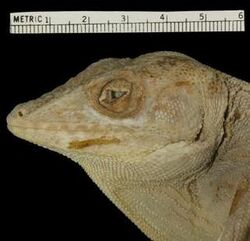Biology:Anolis roosevelti
| Culebra Island giant anole | |
|---|---|

| |
| Scientific classification | |
| Domain: | Eukaryota |
| Kingdom: | Animalia |
| Phylum: | Chordata |
| Class: | Reptilia |
| Order: | Squamata |
| Suborder: | Iguania |
| Family: | Dactyloidae |
| Genus: | Anolis |
| Species: | A. roosevelti
|
| Binomial name | |
| Anolis roosevelti Grant, 1931
| |
| Synonyms[1] | |
| |
Anolis roosevelti, also known commonly as the Virgin Islands giant anole, Roosevelt's giant anole or the Culebra giant anole, is an extremely rare or possibly extinct species of lizard of the genus Anolis in the family Dactyloidae. The species is native to the Virgin Islands and Vieques.
Taxonomy and etymology
The Culebra Island giant anole was first described in 1931 by American zoologist Chapman Grant, grandson of U.S. President Grant. It is named in honor of Theodore Roosevelt Jr., who was the governor of Puerto Rico at that time.[2] It was initially described as Anolis roosevelti, but some have suggested it should be transferred into the genus Xiphosurus in 2012.[3] This new classification system is controversial and many have preferred to maintain all anoles in genus Anolis.[4]
Geographic range
Anolis roosevelti is endemic to Culebra Island in Puerto Rico, and the Virgin Islands.[1]
Habitat
A. roosevelti lives in forested zones[5] on the slopes of Mt. Resaca.[citation needed]
Description
A. roosevelti can reach a snout-to-vent length (SVL) of 160 mm (6.3 in). The color of the body is brown-grey, while the tail has a yellow-brown hue and the abdomen is whitish. The throat fan varies from gray on the upperparts to yellow on the underparts, and the eyelids are yellow. A further feature are two long drawn-out lines on both sides of the body; one starts at the ear, the other at the shoulder.[citation needed]
Reproduction
A. roosevelti is oviparous.[1]
Threats
Though A. roosevelti was only observed again in 1932 after its discovery, there have been unconfirmed sightings since 1973 (the last one in 1978). Some experts believe that it might still exist. It preferred a habitat with gumbo-limbo and ficus trees because it fed from the fruits of the trees. Due to human activities the habitat was almost destroyed; only a few specimens of the Culebra Giant Anole can be seen in museums. It was listed as federally endangered in the Endangered Species Act in 1977.[citation needed]
See also
- Fauna of Puerto Rico
- List of endemic fauna of Puerto Rico
References
- ↑ 1.0 1.1 1.2 Species Anolis roosevelti at The Reptile Database www.reptile-database.org.
- ↑ Beolens, Bo; Watkins, Michael; Grayson, Michael (2011). The Eponym Dictionary of Reptiles. Baltimore: Johns Hopkins University Press. xiii + 296 pp. ISBN:978-1-4214-0135-5. (Anolis roosevelti, p. 226).
- ↑ Nicholson KE, Crother BI, Guyer C, Savage JM (2012). "It is time for a new classification of anoles (Squamata: Dactyloidae)". Zootaxa 3477: 1–108.
- ↑ Poe S (2013). "1986 Redux: New genera of anoles (Squamata: Dactyloidae) are unwarranted". Zootaxa 3626 (2): 295-299.
- ↑ Cite error: Invalid
<ref>tag; no text was provided for refs namediucn status 18 November 2021
Further reading
- Grant C (1931). "A New Species and Two New Subspecies of the Genus Anolis ". Journal of the Department of Agriculture of Porto Rico 15 (3): 219–222. (Anolis roosevelti, new species, p. 219).
- Schwartz A, Thomas R (1975). A Check-list of West Indian Amphibians and Reptiles. Carnegie Museum of Natural History Special Publication No. 1. Pittsburgh, Pennsylvania: Carnegie Museum of Natural History. 216 pp. (Anolis roosevelti, p. 99).
External links
- Culebra Island Giant Anole
- U.S. Fish and Wildlife Service Division of Endangered Species - Culebra Island Giant Anole
- Giant Puerto Rico Lizard listed as Endangered Species
Wikidata ☰ Q370190 entry
 |


